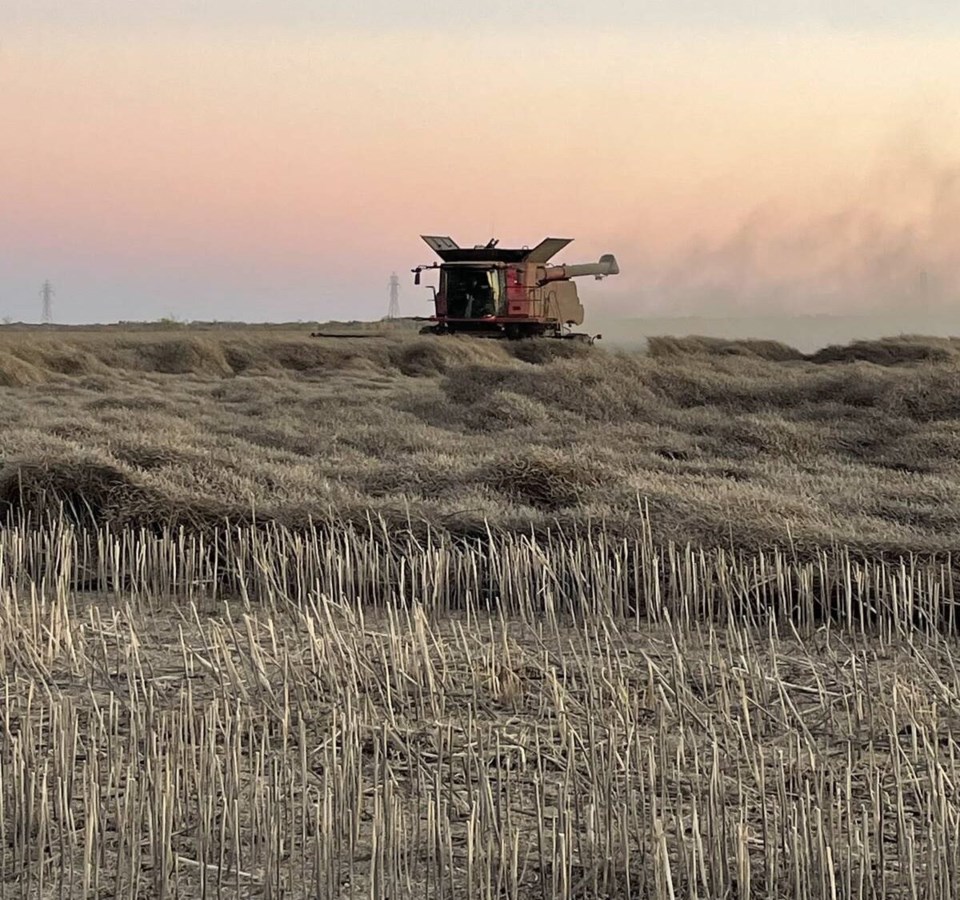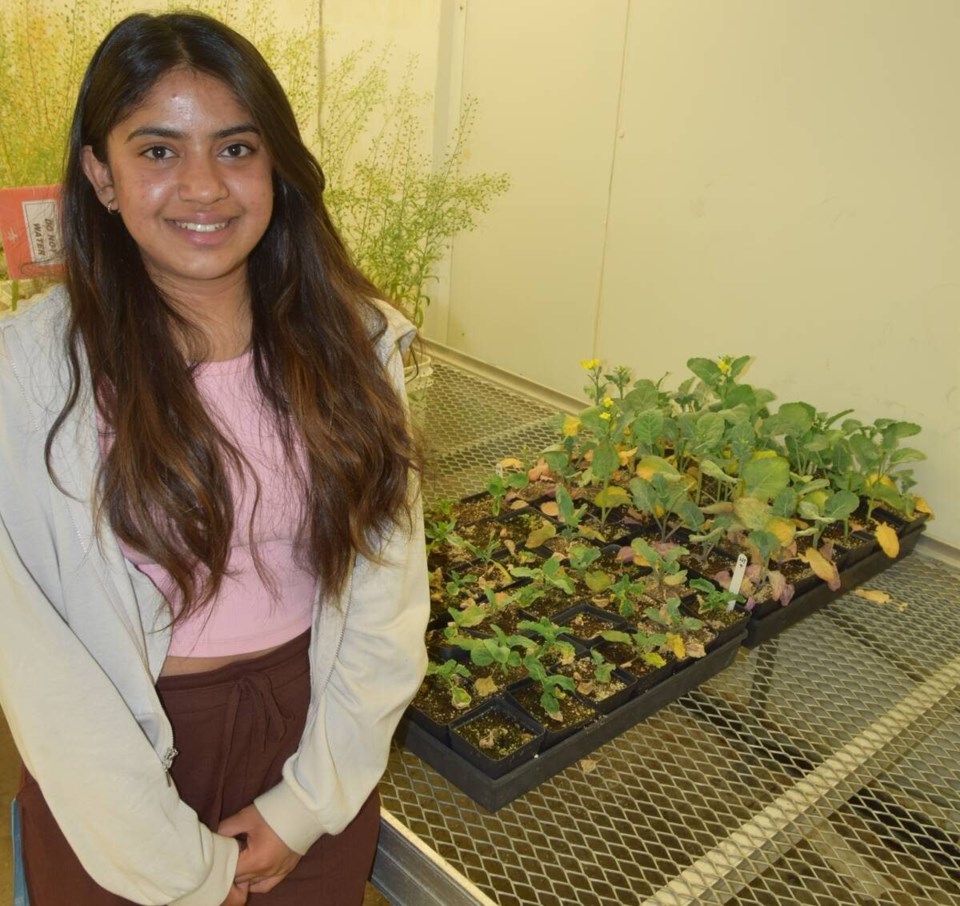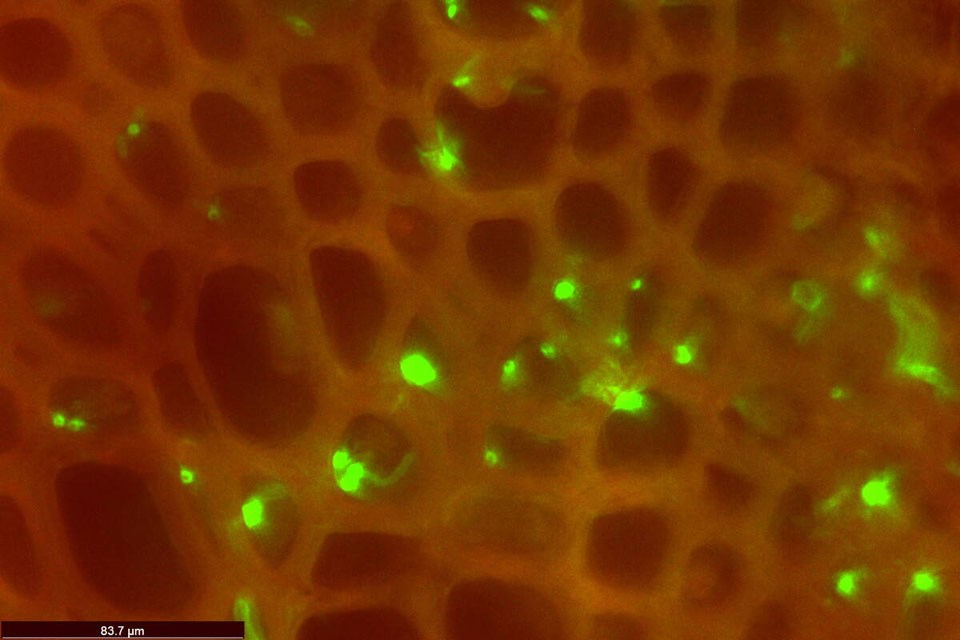UNIVERSITY OF MANITOBA — Two years ago, Brad Crammond had to “scrape some (of) his canola off the ground at harvest,” because verticillium stripe had caused such heavy lodging.
“It was not fun,” said the farmer from Austin, Man. “The last half, I thought we’d never finish because it was so terrible.”
Last year, Crammon also saw the disease, but not to the same degree.
“It’s hard to describe why,” he said. “It’s not present in every field, or every year, or in every cultivar.”
Seed genetics will certain play some role, looking at the natural variation between varieties. Seed companies are exploiting this variation, bringing cultivars to market with known enhanced tolerance.
 In 2023, Austin-area farmer Brad Crammond had a lot of flat canola due to verticillium stripe. | Photo by Brad Crammond
In 2023, Austin-area farmer Brad Crammond had a lot of flat canola due to verticillium stripe. | Photo by Brad Crammond
The new cultivar P1540L from Pioneer Hi-Bred has what Corteva calls moderate verticillium stripe tolerance. The company has been screening developmental canola lines for verticillium stripe tolerance for five years.
“We knew after the first year of screening that our germplasm had natural variation,” said Chad Koscielny, North American canola breeding lead for Corteva.
Verticillium stripe results from the fungal pathogen Verticillium longisporum. It’s been around for decades in Europe. Manitoba was the unfortunate front line for the disease, reporting the Prairies’ first case back in 2014.
The disease enters through the roots and blocks nutrient flow within the plant, leading to early dry down and yield loss.
Koscielny takes inspiration from the European experience.
“Verticillium also reared up quickly in European rapeseed,” he said. “Public researchers identified genes that seemed to increase susceptibility to verticillium, and seed companies were able shift towards more tolerant commercial germplasm.”
Verticillium losses in Europe have been minimized, Koscielny said, by removing susceptible germplasm.
BASF has a new InVigor cultivar, L355PC, with improved verticillium stripe tolerance. The company has three verticillium stripe nurseries across the Prairies and has indoor screening. Through these methods, L355PC showed enhanced verticillium stripe tolerance compared to other BASF cultivars, said Clint Jurke, regional technical services manager for the company.
“This is a quantitative type of resistance, which will reduce disease to a degree but will not provide immunity,” he said.
The other type of resistance – qualitative – often comes from single highly effective resistance genes.
 University of Manitoba doctoral student Shruti Kashyap, shown here in the plant growth chamber, is studying early-season moisture as it relates to verticillium disease severity. That led to the discovery that plants with thick suberin-rich roots had lower disease. | Photo by Jay Whetter
University of Manitoba doctoral student Shruti Kashyap, shown here in the plant growth chamber, is studying early-season moisture as it relates to verticillium disease severity. That led to the discovery that plants with thick suberin-rich roots had lower disease. | Photo by Jay Whetter
Manitoba research identifies possible anti-verticillium trait
High suberin levels — which is a natural biopolymer produced by the plant — could be one pathway to quantitative resistance, according to local research.
Plants use suberin to build cell walls, especially in roots. Because verticillium stripe infects canola through the roots, roots with thicker, more suberin-rich, cell walls could mean lower infection levels.
University of Manitoba doctoral student Shruti Kashyap made the suberin discovery while studying early-season moisture as it relates to verticillium stripe severity.
Kashyap had run a two-factor study comparing verticillium stripe infection of canola plants growing in soil with moisture at field capacity (ideal) and soil with moisture at 30 per cent of field capacity (to mimic a drought), using disease-susceptible cultivar Westar in growth chambers. She inoculated the plants with Verticillium longisporum pathogen at the two-leaf stage, and started the moisture treatments two days after inoculation.
After nine days, verticillium infection for plants growing in drought-like conditions reached a severity index of 3.4 to four. (At a rating of nine, the plant is dead). Plants growing in high-moisture conditions had a verticillium severity index of 7.
The experiment confirmed that verticillium stripe is worse when canola plants start out with more moisture. Previous research and field observations suggested that verticillium stripe prefers a “wet spring and dry summer” to have a greater impact on canola yield.
Then came the new discovery.
Kashyap worked with her advisors Claudio Stasolla and Harmeet Chawla, using fluorescent microscopy to visualize verticillium in root cells. This technique, which gives verticillium hyphae one colour and root cells another colour.
Roots with adequate moisture clearly showed more fungal hyphae in the roots, but there was also something else interesting: root cell walls were thicker in the drought-stressed plants.
Because verticillium infects through the cell walls, Kashyap wondered: were these thicker cell walls creating a physical barrier to infection?
Rubber to the road
To test this theory, Kashyap and her co-supervisors acquired arabidopsis plants (thale cress) that had genetic mutations responsible for synthesizing suberin. Some of those plants have mutations to produce a lot of suberin, some have mutations to produce very little.
Arabadopsis is like the lab rat of plants, used around the world for research. International scientific consortiums have arabidopsis seed available with mutations for almost any gene or trait. Labs order seed for the mutation they want, and get small seed lots delivered.
Kashyap will now expose her arabidopsis mutants – both suberin-rich and suberin-poor – to Verticillium longisporum, measure the infection levels and see if it validates what they saw with Westar.
From there, the researchers can check canola lines known to be susceptible or resistant to verticillium stripe to see if the resistant genotypes have thicker root cell walls.
If the suberin connection survives these experiments, the researchers could then find the genetic pathway that imparts high suberin levels and thick root cell walls, and select for that trait.
Kudos for public research
Jurke said public research is essential to help identify the full integrated management package for verticillium stripe management, including research on how the disease works. That can include how long spores persist and the corresponding crop rotation recommendation. Public research was also key in showing that higher verticillium tolerance lurked in the background of canola genetics. “We can certainly utilize the suberin work if it holds up to scrutiny,” Jurke said.
Another need, Jurke adds, is a verticillium stripe rating system for resistance, similar to what the canola seed industry has for other diseases. Common and public parameters would provide a fair comparison of commercial cultivars.
Meanwhile, canola growers can visit plots this summer to compare current cultivar tolerances. For P1540L trial sites, reach out to Pioneer Hi-Bred seed reps. For L355PC, ask BASF reps for demonstration strip trials that include that cultivar. Check what other seed companies have in the pipeline.
About the author
Related Coverage
Soil moisture, more timely application may help limit fall fertilizer loss
Plant tissue tests key to maximize crop health and yield, Canadian experts say
Parties unitedly condemn China tariffs on Canadian canola
Manitoba premier urges federal support in face of Chinese canola tariffs




